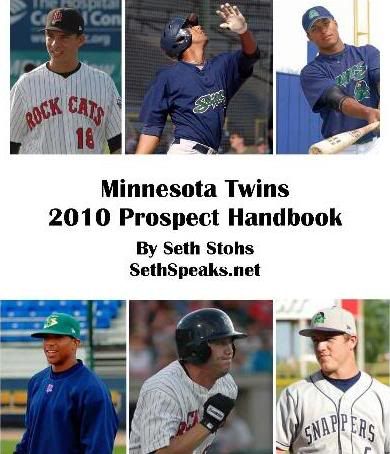There was one glaring difference though. Out of the first 111 picks of the draft, 37 were college pitchers opposed to just 19 high school arms being selected. That was a much bigger spread opposed to the 30-25 differential between high school hitters and college hitters, which favored prep hitters.
The Twins did their part by contributing to the theme of selecting college pitchers by drafting four collegiate pitchers with their first four picks. There was talks leading up to the draft that the Twins would take arms early, but I don't think anyone was expecting them to take them at this magnitude. With the Twins top prospect lists starting to slowly turn into a heavy list of offensively-gifted hitters, pitchers were something the Twins knew they had to take early on. And they wasted no time when selecting the 22nd pick of the draft.
Kyle Gibson was the one of the most talented pitchers and was highly touted heading into the draft. In fact, the University of Missouri product was as recently as last month considered a top five talent. In a May 30th start against Monmouth, Gibson experienced forearm tightness in his arm after throwing 102 pitches over eight innings. Gibson's velocity on his fastball generally sits in the low-mid 90's, but in this start it was averaging between 83-86 mph. Despite not allowing a run, Gibson knew something was wrong and an MRI later revealed a stress fracture in his right forearm.
Stress fracture injuries are tricky. It usually is an underlying to a more pressing issue. For instance, the injury definition can give some thoughts as to why the injury occurred.
Stress Fracture: a fracture caused by unusual or repeated stress on a bone, such as with soldiers or athletes.
That should give readers somewhat of an an incite as to how Gibson acquired the injury. Gibson's workload was a cause of concern all year, even before his injury. Gibson threw five complete games this season, and in 1,566 pitches through 15 starts. If you're doing the math, that's an average of 104.4 pitches per start. He also made a relief appearance where he threw 15 pitches in an inning of work. Obviously, there's no doubt over the amount of work Gibson endured this past season.
Stress Fractures are also indicators of low bone density, although that's not as common in men as it is in women, as well as muscle fatigue.
Muscular fatigue really jumps out. After all, this start when the symptoms reportedly began came on May 30th, 16 games (15 starts) into his season. There's no doubt this was probably a major factor. The repetitive muscle pulling in his forearm and elbow eventually got the best of him and the ulna bone in his forearm eventually fractured. Thankfully, this injury is not considered to be very serious but he'll need to rest for the next 5 weeks with some light exercises beginning between weeks 6-8.
Best-case scenario: Gibson is put into a cast for the next 5+ weeks and after another two-three weeks of strength-building exercises, he returns to the mound in mid-late July.
Worst-case scenario: Gibson's fracture doesn't completely heal and eventually needs surgery which will knock him out for about six months.
There's really nothing the Twins can do at this point, which is somewhat frustrating. But while the it may be most frustrating when other teams' top picks are hitting the diamond for the first time, they'll have to sit and wait to see Gibson finally take the mound. But it could pay dividends for the Twins, who haven't picked a pitcher with their first pick since 2005 (2006-2008, the first player chosen was an outfielder).
Other than the potential, there is one more underlying positive for the Twins. With this injury, he does lose some leverage in contract negotiation. Although he could eventually reconsider and head back to Missouri for his senior year, he'll likely accept whatever the Twins are willing to pay him, which I'm sure they won't be a low ball offer. Remember, the Twins signed their 22nd overall selection in the 2004 draft, Glen Perkins to a $1.425 million deal. Fortunately, that numbers has been at the high scale in that draft slot, which means it hasn't gone up since then. The Twins might be able to sign Gibson to a signing bonus around $1.3 million, which is slightly below the $1.37 million average for the 22nd overall pick since 2003.
Gibson is a physical specimen. Standing 6'6'' and weighing 208 lbs., there's no doubt that his size projects well into the pro's. Although his overall frame is wiry, he does leave room to bulk up. He has two plus-pitches; a low 90's sinking fastball and a hard 10-4 slider that registers in the low-mid 80's on the radar gun. He also has a change-up which could some day also be considered a 'plus pitch'.
Most importantly, while mixing up his pitches, Gibson maintains impeccable control which fits the mold of Twins pitchers. Through 261 innings at Missouri, Gibson has walked only 61 batters while striking out 304. His K:BB ratio is 4.98 while his K:9 is 10.5. His BB:9 is a very solid 2.10. Those aren't Kevin Slowey-esque, but they do remind me a lot of Scott Baker. Gibson and Baker are both similar pitchers with similar builds. Gibson's ceiling is higher than that of Baker's although both project to be #2-3 starters.
Gibson, like Baker, probably won't need a ton of time in the minor leagues. Despite being only 21-years-old, Gibson could probably start in the Midwest League this season and make his way to the Florida State League at the beginning of the 2010 season.
Missouri has produced a few very good pitchers over the past few years, most notably Max Scherzer from the Arizona Diamondbacks. Hopefully Gibson can follow in Scherzer's footsteps and manufacture the same success.


0 comments:
Post a Comment